Cropland Expansion Masks Ecological Degradation: The Unsustainable Greening of China’s Drylands
Abstract
1. Introduction
2. Material and Methods
2.1. Study Area
2.2. Data Sources and Data Pre-Processing
2.3. Methods
2.3.1. Transfer Matrix
2.3.2. Trend Analysis
2.3.3. Multiple Regression and Residual Analysis Method of NDVI
2.3.4. Construction of the RSEI
2.3.5. Habitat Quality
2.3.6. Geographic Detector
2.3.7. Hurst Index
3. Results
3.1. Land Use Change
3.2. Temporal–Spatial Variations in NDVI
3.3. Analysis of Drivers of Change in NDVI
3.4. Temporal–Spatial Variations in RSEI
3.5. Spatiotemporal Analysis of RSEI Levels
3.6. Detecting the Driving Factors for RSEI Spatial Differentiation
3.7. Habitat Quality and Degradation Variations in Space and Time
3.8. Future Trends Change in NDVI
4. Discussion
4.1. Cropland Expansion and the ‘Greening’ Phenomenon
4.2. The Risks Behind “Greening“
4.3. Future Vegetation Changes
5. Conclusions
Author Contributions
Funding
Data Availability Statement
Acknowledgments
Conflicts of Interest
Appendix A
Appendix A.1. Construction of the RSEI
Appendix A.2. Formulas and Input Data for Habitat Quality Model
| Threats | Maximum Distance (km) | Weight (0–1) | Attenuation Types | Land Use Types | ||||||
|---|---|---|---|---|---|---|---|---|---|---|
| Cropland | Grassland | Forest | Water | Wetland | Built-Up Land | Unused Land | ||||
| Habitat suitability score | ||||||||||
| 0.3 | 0.8 | 1 | 0.9 | 1 | 0 | 0 | ||||
| Habitat sensitivity for threats | ||||||||||
| Roads | 3 | 0.7 | Linear | 0.5 | 0.7 | 0.9 | 0.75 | 0.8 | 0 | 0.2 |
| Cropland | 1.5 | 0.5 | Linear | 0 | 0.5 | 0.3 | 0.1 | 0.1 | 0 | 0.1 |
| Built-up land | 8 | 0.8 | Exponential | 0.5 | 0.3 | 0.6 | 0.8 | 0.7 | 0 | 0.1 |
| Population density | 3.5 | 0.3 | Exponential | 0.8 | 0.5 | 0.7 | 0.5 | 0.5 | 0.85 | 0.3 |
Appendix A.3. Trend Analysis Methods Using Theil–Sen Estimator and Mann–Kendall Test
| β | Z | Trend Feature |
|---|---|---|
| β ≥ 0.0005 | Z ≥ 1.96 | Significant increasing |
| −1.96 < Z < 1.96 | Non-significant increasing | |
| −0.0005 < β < 0.0005 | −1.96 < Z < 1.96 | No significant change |
| β < −0.0005 | −1.96 < Z < 1.96 | Significant decreasing |
| Z < −1.96 | Non-significant decreasing |
References
- Lian, X.; Piao, S.; Chen, A.; Huntingford, C.; Fu, B.; Li, L.Z.X.; Huang, J.; Sheffield, J.; Berg, A.M.; Keenan, T.F.; et al. Multifaceted characteristics of dryland aridity changes in a warming world. Nat. Rev. Earth Environ. 2021, 2, 232–250. [Google Scholar] [CrossRef]
- Berdugo, M.; Kéfi, S.; Soliveres, S.; Maestre, F.T. Plant spatial patterns identify alternative ecosystem multifunctionality states in global drylands. Nat. Ecol. Evol. 2017, 1, 0003. [Google Scholar] [CrossRef] [PubMed]
- Niu, G.; Zheng, Y.; Han, F.; Qin, H. The nexus of water, ecosystems and agriculture in arid areas: A multiobjective optimization study on system efficiencies. Agric. Water Manag. 2019, 223, 105697. [Google Scholar] [CrossRef]
- Xu, W.; Su, X. Challenges and impacts of climate change and human activities on groundwater-dependent ecosystems in arid areas—A case study of the Nalenggele alluvial fan in NW China. J. Hydrol. 2019, 573, 376–385. [Google Scholar] [CrossRef]
- Ge, G.; Shi, Z.; Zhu, Y.; Yang, X.; Hao, Y. Land use/cover classification in an arid desert-oasis mosaic landscape of China using remote sensed imagery: Performance assessment of four machine learning algorithms. Glob. Ecol. Conserv. 2020, 22, e00971. [Google Scholar] [CrossRef]
- Li, C.J.; Fu, B.J.; Wang, S.; Stringer, L.C.; Wang, Y.P.; Li, Z.D.; Liu, Y.X.; Zhou, W.X. Drivers and impacts of changes in China’s drylands. Nat. Rev. Earth Environ. 2021, 2, 858–873. [Google Scholar] [CrossRef]
- Xue, J.; Gui, D.; Lei, J.; Sun, H.; Zeng, F.; Mao, D.; Jin, Q.; Liu, Y. Oasification: An unable evasive process in fighting against desertification for the sustainable development of arid and semiarid regions of China. Catena 2019, 179, 197–209. [Google Scholar] [CrossRef]
- Chen, P.; Wang, S.; Liu, Y.X.; Wang, Y.J.; Song, J.X.; Tang, Q.; Yao, Y.; Wang, Y.P.; Wu, X.T.; Wei, F.L.; et al. Spatio-Temporal Dynamics of Aboveground Biomass in China’s Oasis Grasslands Between 1989 and 2021. Earth’s Future 2024, 12, e2023EF003944. [Google Scholar] [CrossRef]
- Tietjen, B.; Schlaepfer, D.R.; Bradford, J.B.; Lauenroth, W.K.; Hall, S.A.; Duniway, M.C.; Hochstrasser, T.; Jia, G.; Munson, S.M.; Pyke, D.A.; et al. Climate change-induced vegetation shifts lead to more ecological droughts despite projected rainfall increases in many global temperate drylands. Glob. Chang. Biol. 2017, 23, 2743–2754. [Google Scholar] [CrossRef]
- Wang, Y.; Li, Y. Land exploitation resulting in soil salinization in a desert-oasis ecotone. Catena 2013, 100, 50–56. [Google Scholar] [CrossRef]
- He, L.; Guo, J.; Jiang, Q.; Zhang, Z.; Yu, S. How did the Chinese Loess Plateau turn green from 2001 to 2020? An explanation using satellite data. Catena 2022, 214, 106246. [Google Scholar] [CrossRef]
- Li, X.; Wang, K.; Huntingford, C.; Zhu, Z.; Peñuelas, J.; Myneni, R.B.; Piao, S. Vegetation greenness in 2023. Nat. Rev. Earth Environ. 2024, 5, 241–243. [Google Scholar] [CrossRef]
- Zhang, J.; Zhang, P.; Deng, X.; Ren, C.; Deng, M.; Wang, S.; Lai, X.; Long, A. Study on the Spatial and Temporal Trends of Ecological Environment Quality and Influencing Factors in Xinjiang Oasis. Remote Sens. 2024, 16, 1980. [Google Scholar] [CrossRef]
- Gorelick, N.; Hancher, M.; Dixon, M.; Ilyushchenko, S.; Thau, D.; Moore, R. Google Earth Engine: Planetary-scale geospatial analysis for everyone. Remote Sens. Environ. 2017, 202, 18–27. [Google Scholar] [CrossRef]
- Weng, Q.H.; Lu, D.S.; Schubring, J. Estimation of land surface temperature-vegetation abundance relationship for urban heat island studies. Remote Sens. Environ. 2004, 89, 467–483. [Google Scholar] [CrossRef]
- Xu, H.; Wang, Y.; Guan, H.; Shi, T.; Hu, X. Detecting Ecological Changes with a Remote Sensing Based Ecological Index (RSEI) Produced Time Series and Change Vector Analysis. Remote Sens. 2019, 11, 2345. [Google Scholar] [CrossRef]
- Aizizi, Y.; Kasimu, A.; Liang, H.; Zhang, X.; Wei, B.; Zhao, Y.; Ainiwaer, M. Evaluation of Ecological Quality Status and Changing Trend in Arid Land Based on the Remote Sensing Ecological Index: A Case Study in Xinjiang, China. Forests 2023, 14, 1830. [Google Scholar] [CrossRef]
- Tang, J.; Zhou, L.; Dang, X.; Hu, F.; Yuan, B.; Yuan, Z.; Wei, L. Impacts and predictions of urban expansion on habitat quality in the densely populated areas: A case study of the Yellow River Basin, China. Ecol. Indic. 2023, 151, 110320. [Google Scholar] [CrossRef]
- Yang, H.; Yu, J.; Xu, W.; Wu, Y.; Lei, X.; Ye, J.; Geng, J.; Ding, Z. Long-time series ecological environment quality monitoring and cause analysis in the Dianchi Lake Basin, China. Ecol. Indic. 2023, 148, 110084. [Google Scholar] [CrossRef]
- Zhang, W.; Liu, Z.; Qin, K.; Dai, S.; Lu, H.; Lu, M.; Ji, J.; Yang, Z.; Chen, C.; Jia, P. Long-Term Dynamic Monitoring and Driving Force Analysis of Eco-Environmental Quality in China. Remote Sens. 2024, 16, 1028. [Google Scholar] [CrossRef]
- Aizizi, Y.; Kasimu, A.; Liang, H.; Zhang, X.; Zhao, Y.; Wei, B. Evaluation of ecological space and ecological quality changes in urban agglomeration on the northern slope of the Tianshan Mountains. Ecol. Indic. 2023, 146, 109896. [Google Scholar] [CrossRef]
- Yohannes, H.; Soromessa, T.; Argaw, M.; Dewan, A. Spatio-temporal changes in habitat quality and linkage with landscape characteristics in the Beressa watershed, Blue Nile basin of Ethiopian highlands. J. Environ. Manag. 2020, 281, 111885. [Google Scholar] [CrossRef]
- Aneseyee, A.B.; Noszczyk, T.; Soromessa, T.; Elias, E. The InVEST Habitat Quality Model Associated with Land Use/Cover Changes: A Qualitative Case Study of the Winike Watershed in the Omo-Gibe Basin, Southwest Ethiopia. Remote Sens. 2020, 12, 1103. [Google Scholar] [CrossRef]
- Wu, C.; Deng, L.; Huang, C.; Chen, Y.; Peng, C. Effects of vegetation restoration on soil nutrients, plant diversity, and its spatiotemporal heterogeneity in adesert-oasisecotone. Land Degrad. Dev. 2021, 32, 670–683. [Google Scholar] [CrossRef]
- Li, Y.; Wang, Y.G.; Houghton, R.A.; Tang, L. Hidden carbon sink beneath desert. Geophys. Res. Lett. 2015, 42, 5880–5887. [Google Scholar] [CrossRef]
- Wang, Y.; Long, A.; Xiang, L.; Deng, X.; Pei, Z.; Yang, H.; Jie, W.; Yang, L. The verification of Jevons’ paradox of agricultural Water conservation in Tianshan District of China based on Water footprint. Agric. Water Manag. 2020, 239, 106163. [Google Scholar] [CrossRef]
- Zhao, N.; Zheng, X.; Zhang, B.; Tian, S.; Du, L.; Li, Y. Does water-saving irrigation truly conserve water? Yes and No. Agric. Water Manag. 2025, 311, 109399. [Google Scholar] [CrossRef]
- Peng, S.; Ding, Y.; Liu, W.; Li, Z. 1 km monthly temperature and precipitation dataset for China from 1901 to 2017. Earth Syst. Sci. Data 2019, 11, 1931–1946. [Google Scholar] [CrossRef]
- Peng, S.; Ding, Y.; Wen, Z.; Chen, Y.; Cao, Y.; Ren, J. Spatiotemporal change and trend analysis of potential evapotranspiration over the Loess Plateau of China during 2011–2100. Agric. For. Meteorol. 2017, 233, 183–194. [Google Scholar] [CrossRef]
- Peng, S.; Gang, C.; Cao, Y.; Chen, Y. Assessment of climate change trends over the Loess Plateau in China from 1901 to 2100. Int. J. Climatol. 2018, 38, 2250–2264. [Google Scholar] [CrossRef]
- Ding, Y.; Peng, S. Spatiotemporal trends and attribution of drought across China from 1901–2100. Sustainability 2020, 12, 477. [Google Scholar] [CrossRef]
- Yang, J.; Huang, X. The 30 m annual land cover dataset and its dynamics in China from 1990 to 2019. Earth Syst. Sci. Data 2021, 13, 3907–3925. [Google Scholar] [CrossRef]
- Aguiar, R.; Collares-Pereira, M.; Conde, J. Simple procedure for generating sequences of daily radiation values using a library of Markov transition matrices. Sol. Energy 1988, 40, 269–279. [Google Scholar] [CrossRef]
- Evans, J.; Geerken, R. Discrimination between climate and human-induced dryland degradation. J. Arid Environ. 2004, 57, 535–554. [Google Scholar] [CrossRef]
- Wang, J.; Xu, C. Geodetector: Principle and prospective. Acta Geogr. Sin. 2017, 72, 116–134. [Google Scholar] [CrossRef]
- Song, Y.; Wang, J.; Ge, Y.; Xu, C. An optimal parameters-based geographical detector model enhances geographic characteristics of explanatory variables for spatial heterogeneity analysis: Cases with different types of spatial data. GISci. Remote Sens. 2020, 57, 593–610. [Google Scholar] [CrossRef]
- Jiang, W.; Yuan, L.; Wang, W.; Cao, R.; Zhang, Y.; Shen, W.M. Spatio-temporal analysis of vegetation variation in the Yellow River Basin. Ecol. Indic. 2015, 51, 117–126. [Google Scholar] [CrossRef]
- Chen, C.; Park, T.; Wang, X.; Piao, S.; Xu, B.; Chaturvedi, R.K.; Fuchs, R.; Brovkin, V.; Ciais, P.; Fensholt, R.; et al. China and India lead in greening of the world through land-use management. Nat. Sustain. 2019, 2, 122–129. [Google Scholar] [CrossRef]
- Thomas, F.M.; Foetzki, A.; Arndt, S.K.; Bruelheide, H.; Gries, D.; Li, X.; Zeng, F.; Zhang, X.; Runge, M. Water use by perennial plants in the transition zone between river oasis and desert in NW China. Basic Appl. Ecol. 2006, 7, 253–267. [Google Scholar] [CrossRef]
- Wang, G.; Munson, S.M.; Yu, K.; Chen, N.; Gou, Q. Ecological effects of establishing a 40-year oasis protection system in a northwestern China desert. Catena 2020, 187, 104374. [Google Scholar] [CrossRef]
- Sawut, M.; Eziz, M.; Tiyip, T. The effects of land-use change on ecosystem service value of desert oasis: A case study in Ugan-Kuqa River Delta Oasis, China. Can. J. Soil Sci. 2013, 93, 99–108. [Google Scholar] [CrossRef]
- Su, Y.Z.; Zhao, W.Z.; Su, P.X.; Zhang, Z.H.; Wang, T.; Ram, R. Ecological effects of desertification control and desertified land reclamation in an oasis-desert ecotone in an and region: A case study in Hexi Corridor, northwest China. Ecol. Eng. 2007, 29, 117–124. [Google Scholar] [CrossRef]
- Lai, J.M.; Li, Y.A.; Chen, J.L.; Niu, G.Y.; Lin, P.R.; Li, Q.; Wang, L.X.; Han, J.M.; Luo, Z.Q.; Sun, Y. Massive crop expansion threatens agriculture and water sustainability in northwestern China. Environ. Res. Lett. 2022, 17, 034003. [Google Scholar] [CrossRef]
- Abliz, A.; Tiyip, T.; Ghulam, A.; Halik, Ü.; Ding, J.L.; Sawut, M.; Zhang, F.; Nurmemet, I. Effects of shallow groundwater table and salinity on soil salt dynamics in the Keriya Oasis, Northwestern China. Environ. Earth Sci. 2016, 75, 260. [Google Scholar] [CrossRef]
- Kendy, E.; Zhang, Y.; Liu, C.; Wang, J.; Steenhuis, T. Groundwater recharge from irrigated cropland in the North China Plain: Case study of Luancheng County, Hebei Province, 1949–2000. Hydrol. Process. 2004, 18, 2289–2302. [Google Scholar] [CrossRef]
- Yin, X.W.; Feng, Q.; Li, Y.; Deo, R.C.; Liu, W.; Zhu, M.; Zheng, X.J.; Liu, R. An interplay of soil salinization and groundwater degradation threatening coexistence of oasis-desert ecosystems. Sci. Total Environ. 2022, 806, 150599. [Google Scholar] [CrossRef]
- Dai, Y.; Zheng, X.J.; Tang, L.S.; Li, Y. Stable oxygen isotopes reveal distinct water use patterns of two Haloxylon species in the Gurbantonggut Desert. Plant Soil 2015, 389, 73–87. [Google Scholar] [CrossRef]
- Wu, X.; Zheng, X.J.; Yin, X.W.; Yue, Y.M.; Liu, R.; Xu, G.Q.; Li, Y. Seasonal variation in the groundwater dependency of two dominant woody species in a desert region of Central Asia. Plant Soil 2019, 444, 39–55. [Google Scholar] [CrossRef]
- Reynolds, J.F.; Stafford Smith, D.M.; Lambin, E.F.; Turner, B.L.; Mortimore, M.; Batterbury, S.P.J.; Downing, T.E.; Dowlatabadi, H.; Fernandez, R.J.; Herrick, J.E.; et al. Global desertification: Building a science for dryland development. Science 2007, 316, 847–851. [Google Scholar] [CrossRef]

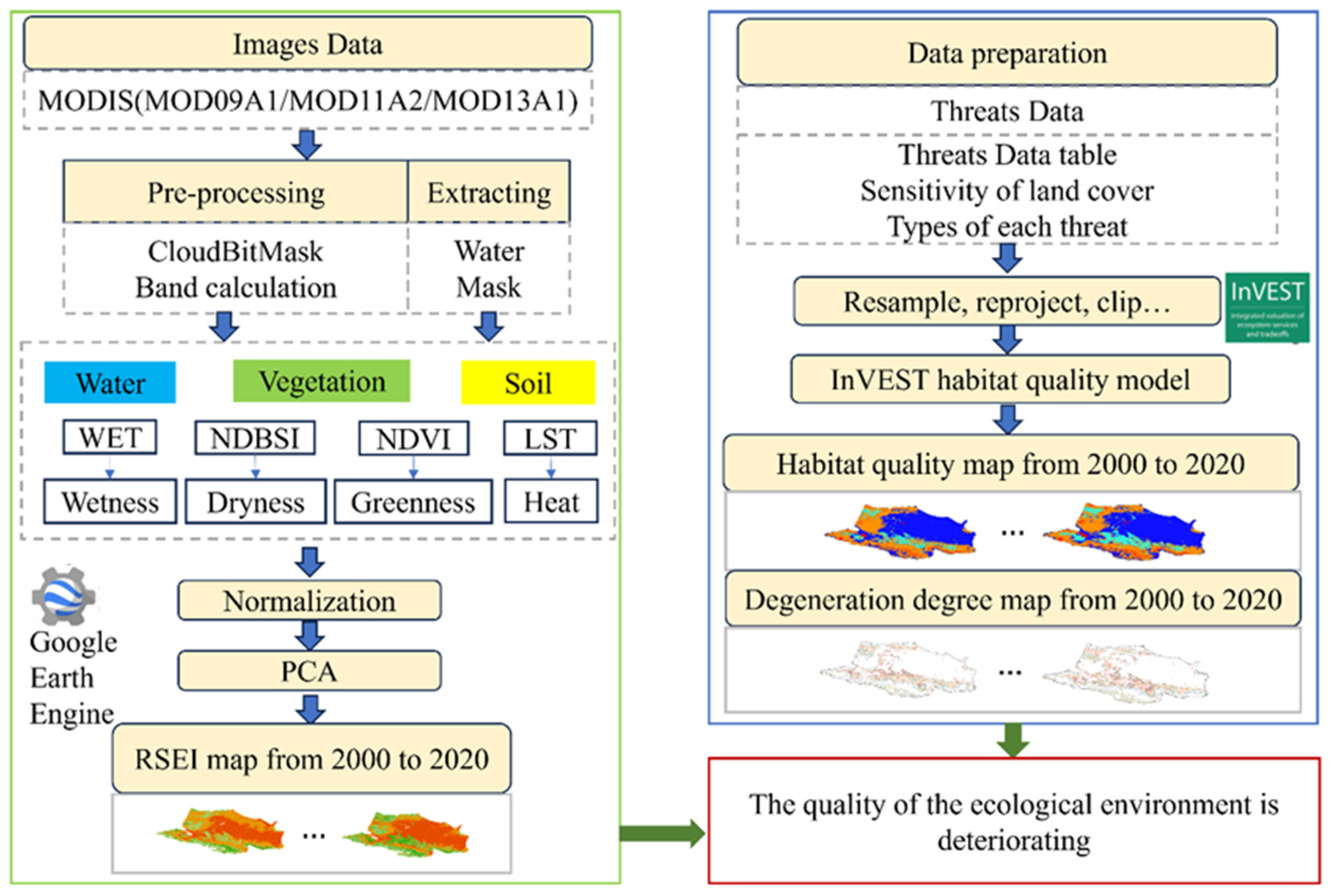
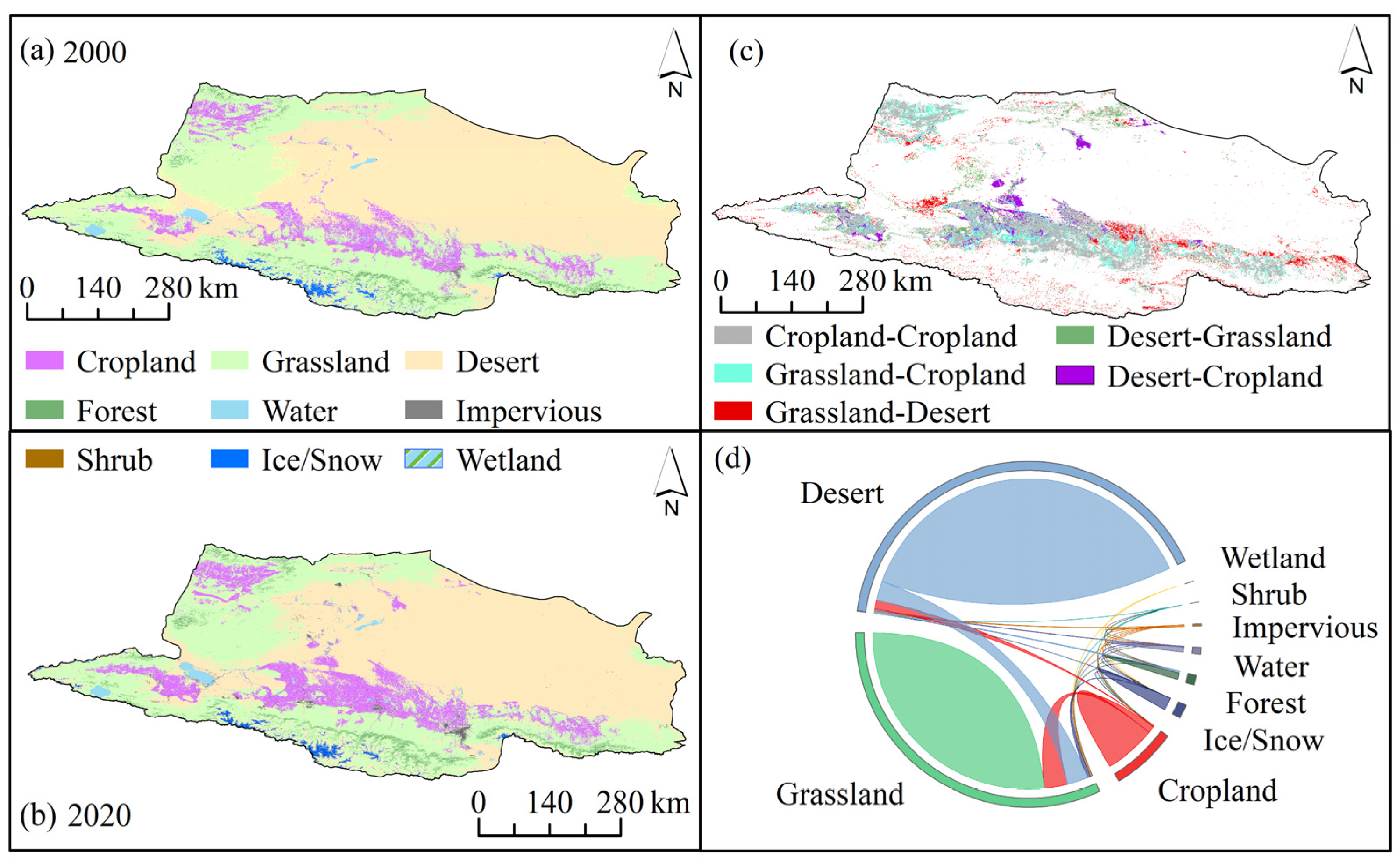
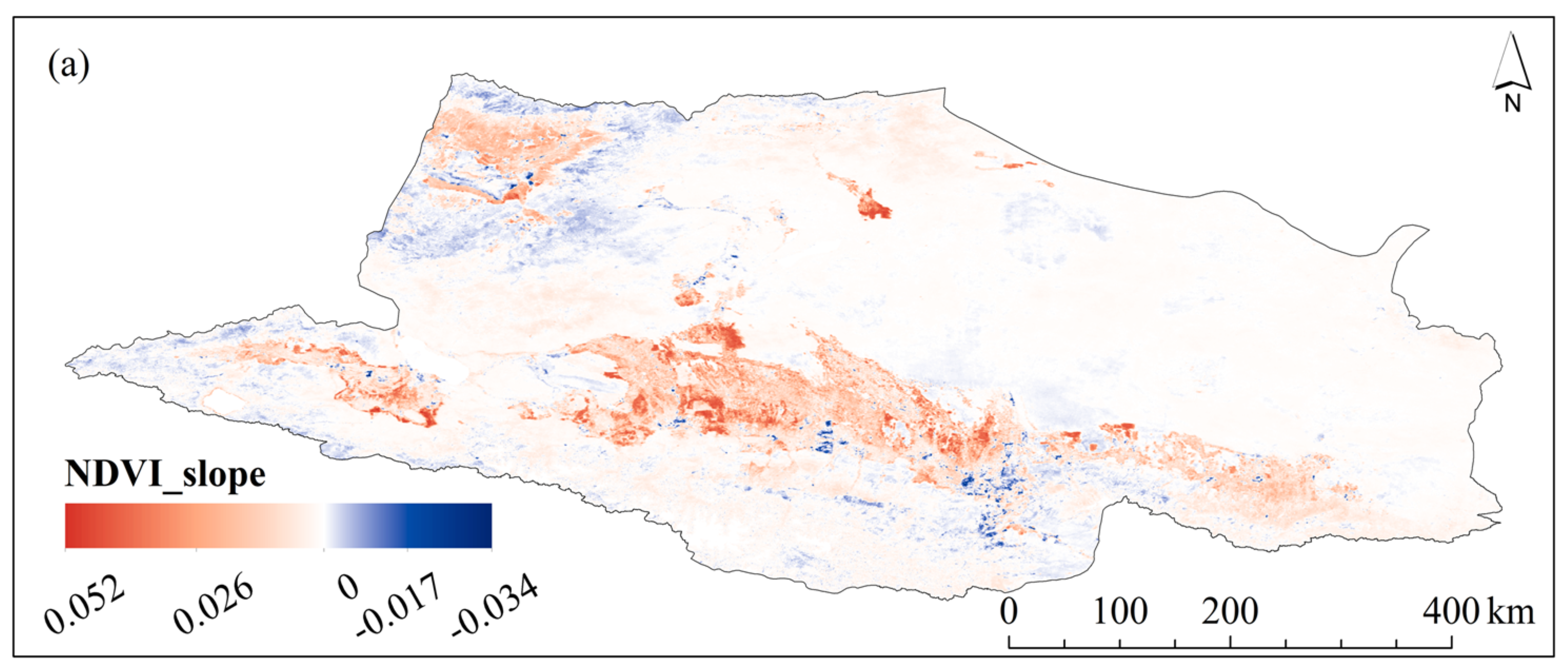

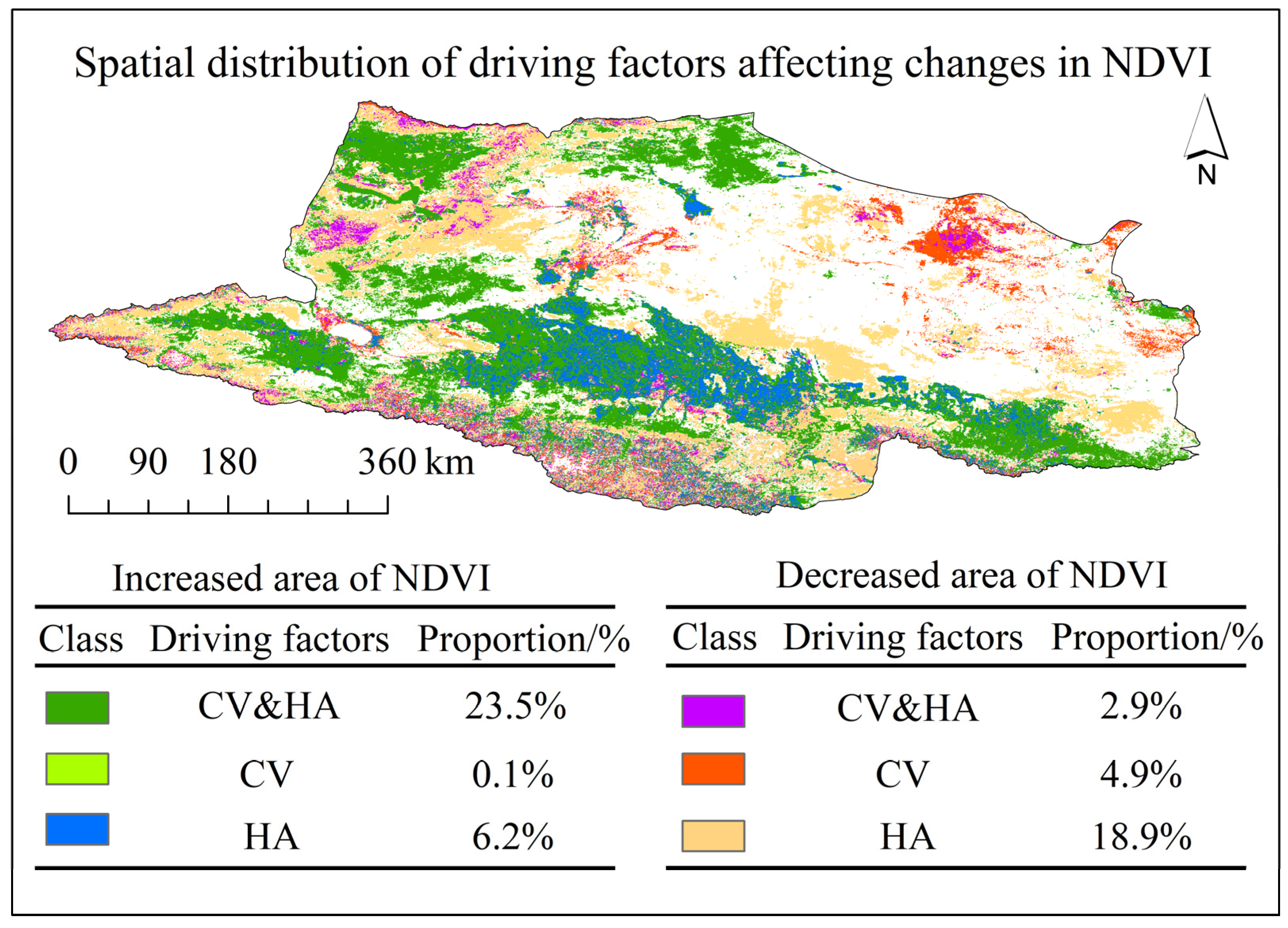
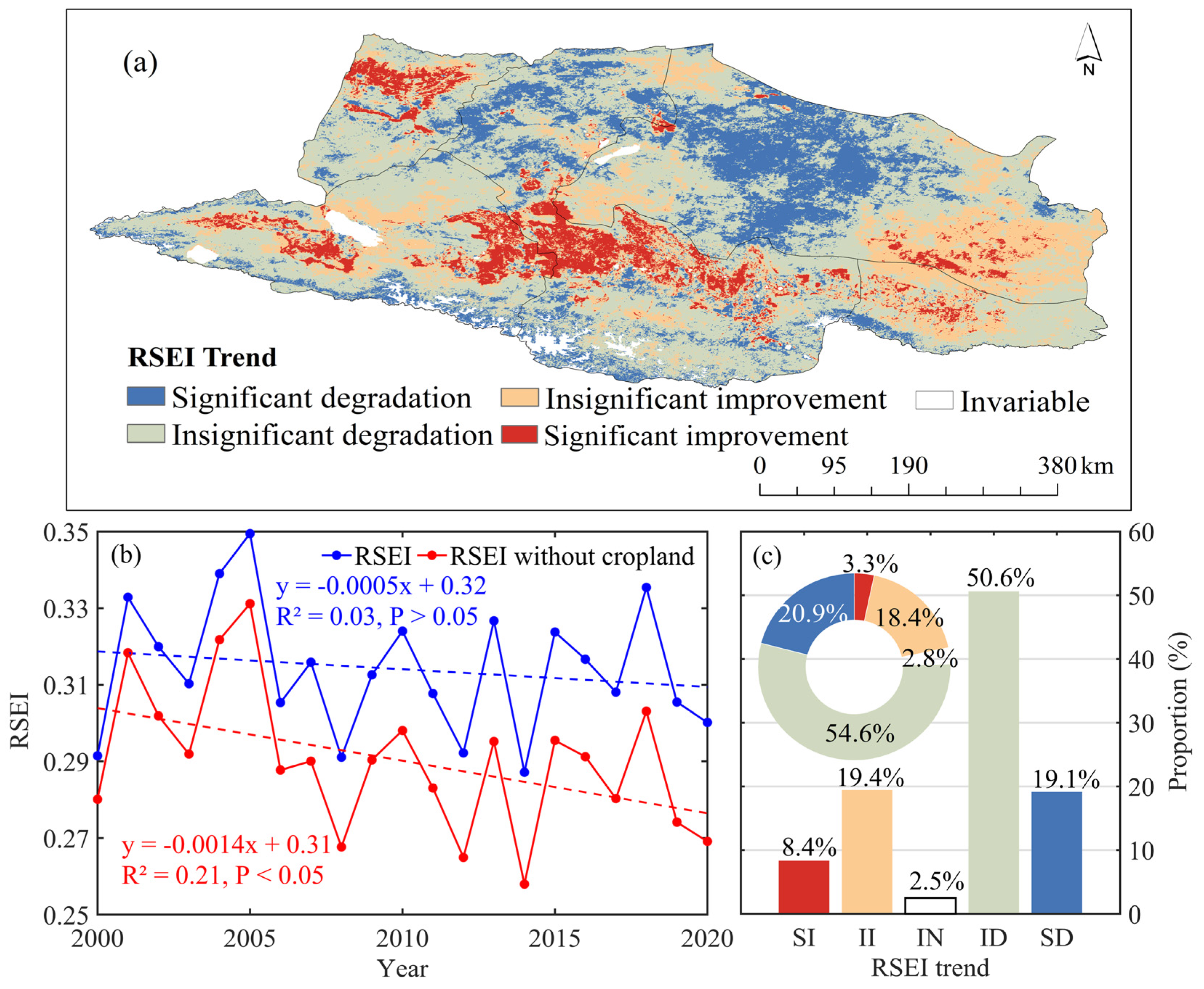
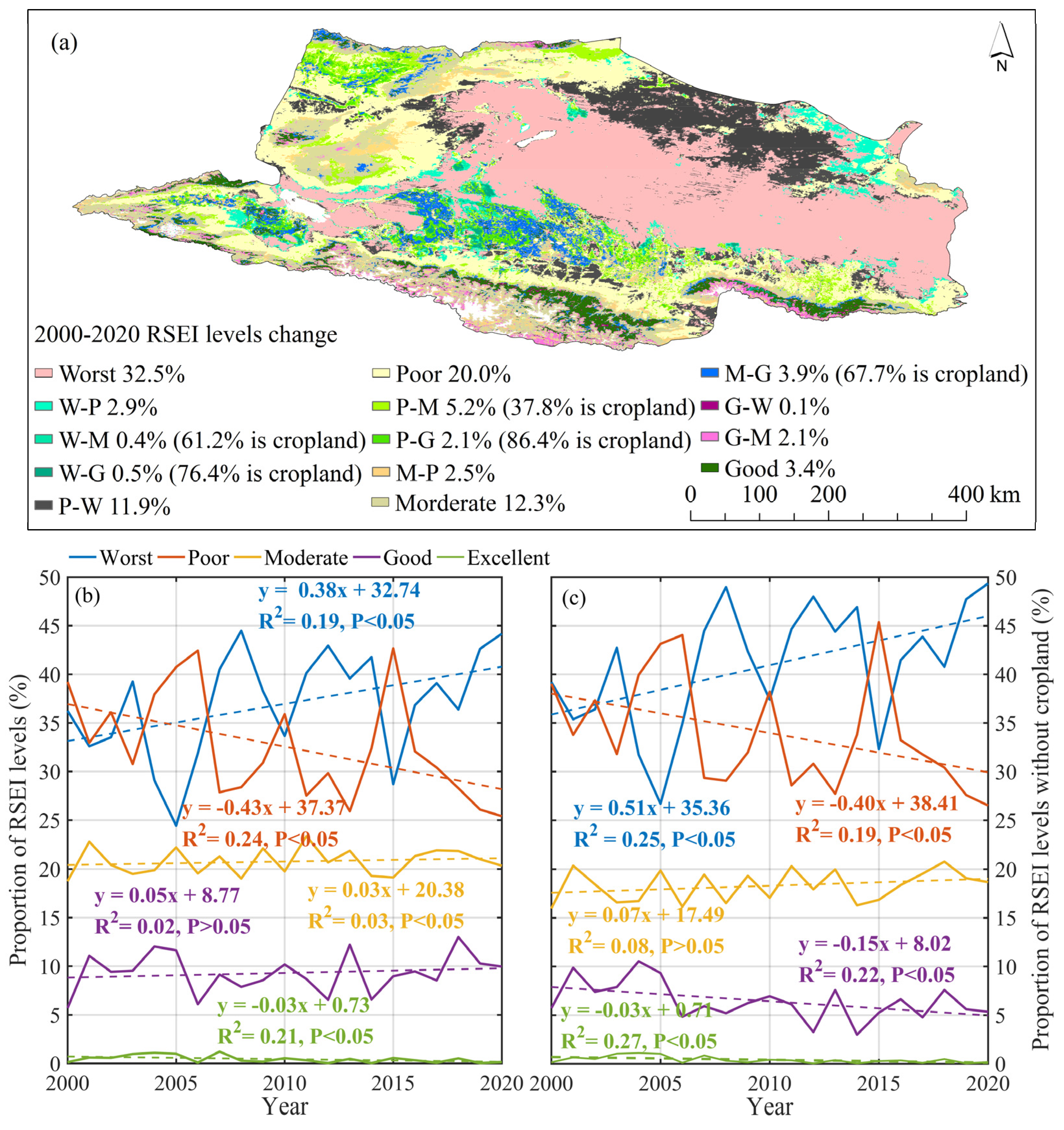
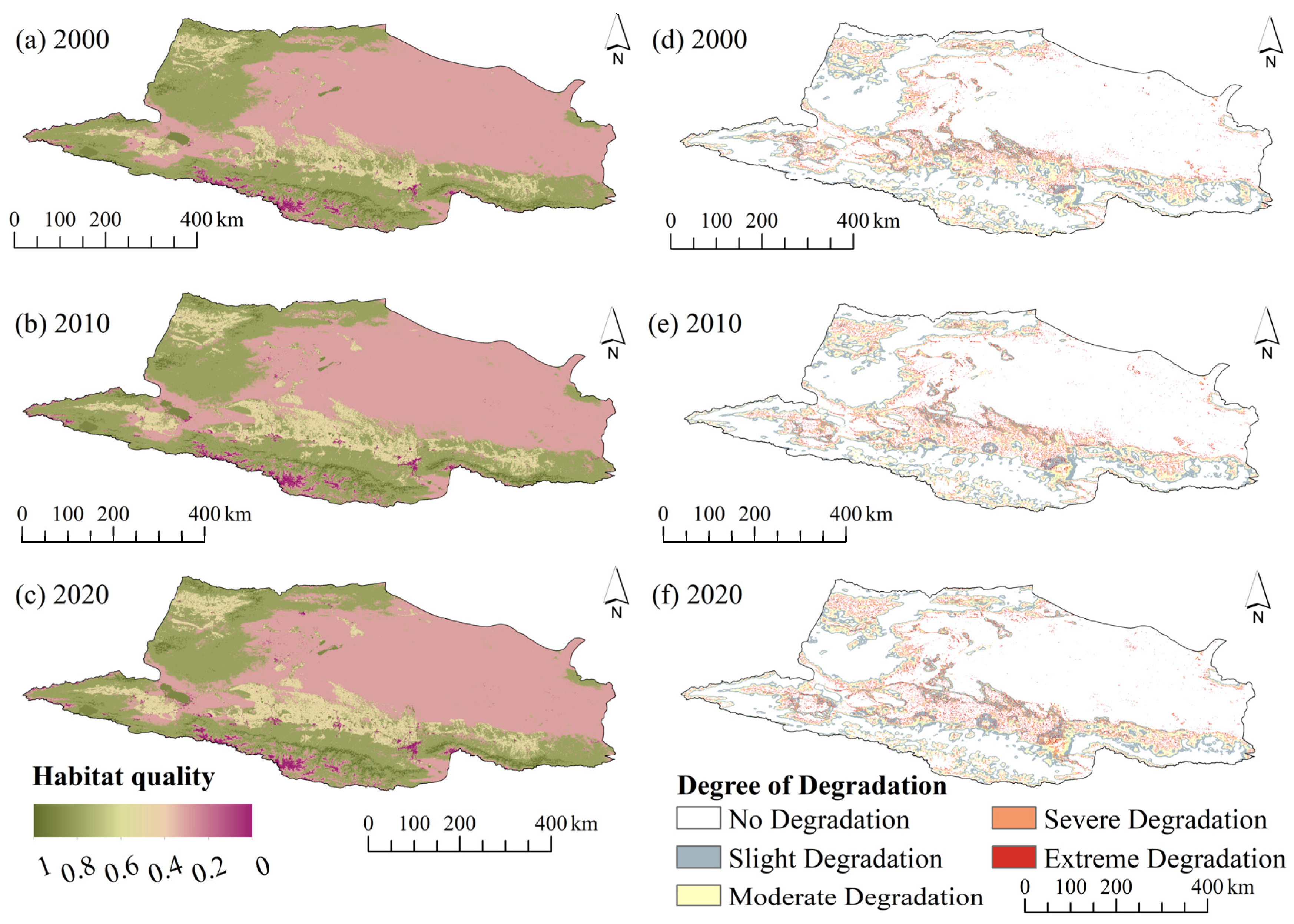

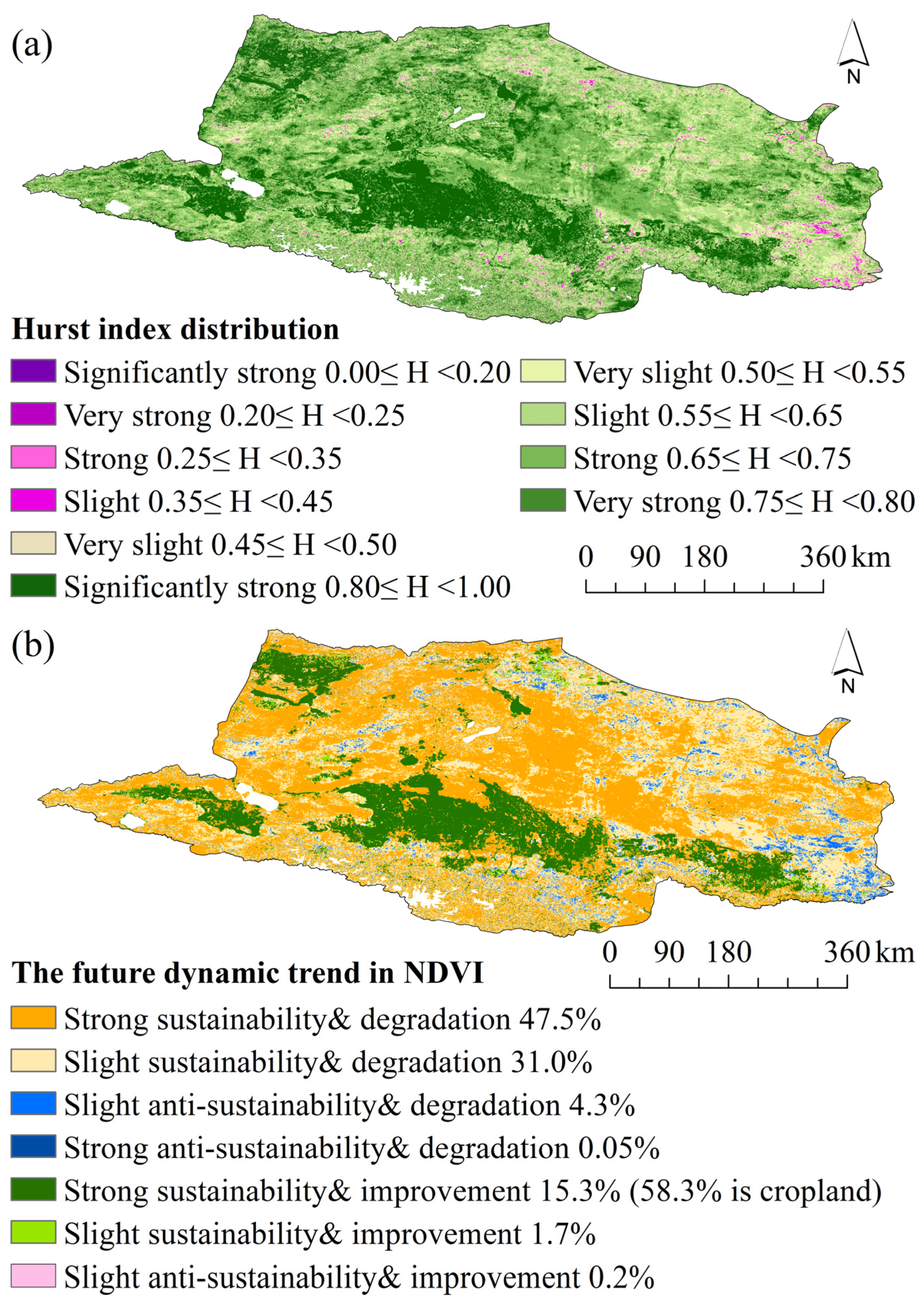
| Data | Sources | Spatial Resolution |
|---|---|---|
| Meteorological data | National Tibetan Plateau/Third Pole Environment Data Center (http://data.tpdc.ac.cn, accessed on 10 January 2024). | 1 km |
| Elevation | Resource and Environment Science and Data Center (https://www.resdc.cn/, accessed on 1 July 2024). | 500 m |
| Land use/cover | Landsat-derived annual land cover product of China (CLCD) (http://doi.org/10.5281/zenodo.4417809, accessed on 10 January 2024). | 30 m |
| Road network datasets | OpenStreetMap (OSM), (https://download.geofabrik.de/, accessed on 15 January 2024) | _ |
| Population density | Worldpop (https://hub.worldpop.org/project/categories?id=18, accessed on 15 January 2024) | 1 km |
| Cropland acreage | Xinjiang Statistical Yearbook (2000–2020) | _ |
| Influence Factor | 2000 q Value | 2005 q Value | 2010 q Value | 2015 q Value | 2020 q Value | 2000–2020 q Value |
|---|---|---|---|---|---|---|
| NDVI | 0.61 | 0.7 | 0.7 | 0.75 | 0.78 | 0.72 |
| WET | 0.18 | 0.43 | 0.43 | 0.47 | 0.53 | 0.58 |
| LST | 0.79 | 0.69 | 0.69 | 0.62 | 0.57 | 0.48 |
| NDBSI | 0.47 | 0.51 | 0.51 | 0.63 | 0.65 | 0.21 |
| LAI | 0.53 | 0.63 | 0.63 | 0.71 | 0.74 | 0.54 |
| Elev | 0.55 | 0.41 | 0.41 | 0.23 | 0.26 | - |
| Prec | 0.29 | 0.24 | 0.24 | 0.1 | 0.18 | 0.04 |
| Temp | 0.49 | 0.32 | 0.32 | 0.16 | 0.23 | 0.07 |
| LUCC | 0.34 | 0.4 | 0.4 | 0.46 | 0.48 | 0.41 |
Disclaimer/Publisher’s Note: The statements, opinions and data contained in all publications are solely those of the individual author(s) and contributor(s) and not of MDPI and/or the editor(s). MDPI and/or the editor(s) disclaim responsibility for any injury to people or property resulting from any ideas, methods, instructions or products referred to in the content. |
© 2025 by the authors. Licensee MDPI, Basel, Switzerland. This article is an open access article distributed under the terms and conditions of the Creative Commons Attribution (CC BY) license (https://creativecommons.org/licenses/by/4.0/).
Share and Cite
Zhao, N.; Du, L.; Tian, S.; Zhang, B.; Zheng, X.; Li, Y. Cropland Expansion Masks Ecological Degradation: The Unsustainable Greening of China’s Drylands. Agronomy 2025, 15, 1162. https://doi.org/10.3390/agronomy15051162
Zhao N, Du L, Tian S, Zhang B, Zheng X, Li Y. Cropland Expansion Masks Ecological Degradation: The Unsustainable Greening of China’s Drylands. Agronomy. 2025; 15(5):1162. https://doi.org/10.3390/agronomy15051162
Chicago/Turabian StyleZhao, Nan, Lan Du, Shengchuan Tian, Bin Zhang, Xinjun Zheng, and Yan Li. 2025. "Cropland Expansion Masks Ecological Degradation: The Unsustainable Greening of China’s Drylands" Agronomy 15, no. 5: 1162. https://doi.org/10.3390/agronomy15051162
APA StyleZhao, N., Du, L., Tian, S., Zhang, B., Zheng, X., & Li, Y. (2025). Cropland Expansion Masks Ecological Degradation: The Unsustainable Greening of China’s Drylands. Agronomy, 15(5), 1162. https://doi.org/10.3390/agronomy15051162







